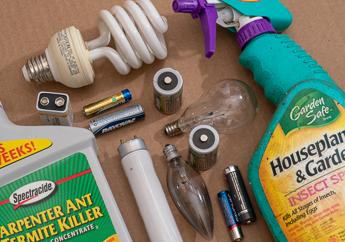
Almost all Missourians use household products that have the potential to be hazardous. Ordinary products such as cleaning products, batteries, light bulbs, paint, pesticides and motor oil can be harmful and potentially dangerous if disposed incorrectly. Some products may cause fires or contaminate our soil, groundwater, lakes and streams. Other products contain chemicals that can expose both children and adults to serious health risks if toxic levels of the chemicals are breathed in, swallowed or come in contact with skin. When these products are not used up completely or are no longer wanted by the consumers, and need to be disposed, they become classified as household hazardous waste.
Listed below are common household hazardous waste items and the steps you should take to properly dispose them. For information about how to manage household hazardous waste after a natural disaster, visit Disaster Resources.
The department also has several guidance documents and other resources available for owners and operators of household hazardous waste facility on our Household Hazardous Waste Facility Guidance Documents and Fact Sheets webpage.
Disclaimer: Any non-department websites listed are for informational purposes only. This is not intended as an endorsement, certification or warranty to any company or product by or from the Missouri Department of Natural Resources.
Miscellaneous
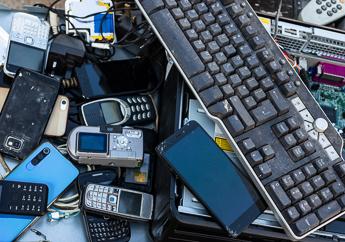
If you need to dispose of major appliances, scrap tires, used oil or lead-acid batteries, review What to Do With Items Banned From Landfills - PUB0186. For information about proper handling and disposal of other miscellaneous items, please review the information below or click on one of the waste-specific headings.
- Antifreeze Waste Management Guide - PUB0114
- Electronics
- Mercury Waste
- Proper Disposal of Household Pharmaceutical Waste - PUB2291
- End-of-Life Solar Panels - EPA
Educational Materials
- Household Hazardous Waste Bookmark - PUB3010
- Household Hazardous Waste Coloring Page - PUB3012
- Household Hazardous Waste Word Search - PUB3011
- Natural Disaster Assistance for Missouri Citizens: Household Chemicals and Household Hazardous Waste - PUB0762
- Reducing the Impact of Flooding: Household Hazardous Waste - PUB2420
Batteries
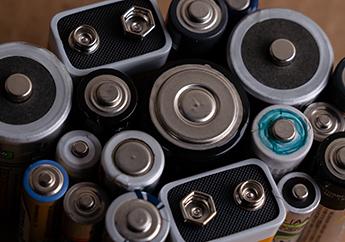
One of the most common potentially hazardous wastes found in homes is batteries. Both single-use and rechargeable batteries may contain a combination of toxic chemicals and heavy metals, including cadmium, lead, lithium, mercury, nickel, silver and zinc. If crushed or broken, these chemicals could be released into the environment. Some batteries can leak corrosive materials with age. It is also important to remember that dead batteries are often times not completely drained. They can cause a fire if short-circuited, punctured, damaged, improperly charged or improperly disposed. If a battery is not explicitly marked as “rechargeable,” do not recharge it. Recharging single-use batteries could cause the battery to leak or rupture.
Reduce, Reuse, Recycle
By properly storing and organizing your batteries, you can maintain product safety and avoid buying what you already have. Also, battery-powered items that are not being used, do not need to have batteries installed. Simply move the unused batteries from one device to another. If you must buy new batteries, consider using rechargeable batteries instead. More uses out of one battery means fewer batteries to dispose in the long run.
Disposal
Tape the ends of the "dead" battery. If a metal object touches the two posts of a 9-volt battery, or comes in contact with more than one regular battery, it can cause a short circuit which can make enough heat to start a fire. The taped battery can then be stored in a plastic bucket until taken to a recycler or placed in the household trash for disposal. If you choose to throw away your used batteries, it is important that you do so in small numbers. For more information about recycling batteries, review Take Charge - Recycle Your Batteries! - PUB2967.
While most standard household batteries can be disposed with household trash, the department recommends taking them to a permanent household hazardous waste collection facility for recycling or disposal. Call2Recycle, a non-profit battery recycling program, provides thousands of battery drop-off locations across the United States. You can also participate in a collection event hosted by your city, county or solid waste management district. You can also search the Missouri Materials Management Directory to find local contractors, vendors and drop-off locations offering recycling and disposal services.
Vehicle Batteries and Energy Storage Systems
If you need to dispose of a traditional lead-acid battery used in cars, boats and other vehicles, review What to Do With Items Banned From Landfills - PUB0186. Use extreme caution with medium- and large-scale lithium-ion batteries found in electric vehicles and energy storage systems. Because of the size and complexity of these battery systems, the consumer may not be able to remove the battery. Refer to the manufacturer’s instructions and heed all warnings and safety instructions. EPA recommends contacting the manufacturer, automobile dealer or company that installed the lithium-ion battery for management options. Do not put these batteries in the trash or municipal recycling bins. If your electric vehicle becomes submerged in water, please follow the warnings and tips provided in the National Fire Protection Association's Submerged Hybrid / Electric Vehicles bulletin.
Cleaning Products

Some household cleaning products contain chemicals that can irritate the skin or cause severe burns if splashed on the skin or in the eyes. Vapors from some chemicals can cause burning eyes, sore throat, coughing, trouble breathing and wheezing. Always read the products warning label and directions for use. Never mix products! When bleach and ammonia products are combined, these two common household cleaners release toxic chloramine gas, which could be deadly.
Reduce, Reuse, Recycle
Of course the ideal situation would be to not have any hazardous cleaning products in the first place. Read labels carefully and use alternative natural products for cleaning when possible. For information about how you can protect your family and the environment by looking for cleaning products with safer ingredients, consider reviewing EPA's Why Choose Safer Cleaning Products? video.
Products such as lemon juice, vinegar and baking soda are environmentally-friendly and inexpensive. Remember to follow the same rules about storing these products and never mix these products together. For more information, visit EPA's Safer Choice or the Ozark Rivers Solid Waste Management District's Safe Alternatives to Household Chemicals.
Before you throw away unwanted cleaning products, consider donating it to a friend, local charity, church or homeless shelter.
Disposal
If you cannot find anyone who needs your unwanted cleaning products, in most cases, the cleaning products can be disposed with your household trash. However, if available, take unwanted cleaning products to a permanent household hazardous waste collection facility or participate in a collection event hosted by your city, county or solid waste management district. You can also search the Missouri Materials Management Directory or Earth911 to find local drop-off locations for recycling specific materials.
Light Bulbs
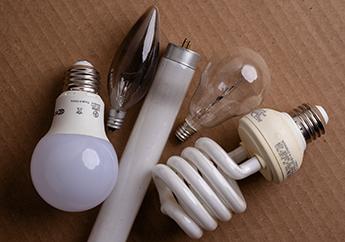
Standard, incandescent bulbs and halogen bulbs do not contain hazardous materials. However, compact fluorescent light (CFLs), fluorescent tubes and light emitting diodes (LED) bulbs contain toxic metals such as mercury, arsenic and lead. CFL light bulbs contain about 3 milligrams of mercury gas. If the bulb breaks, individuals can easily breathe in toxic levels of mercury vapor and other metals.* If the bulbs are improperly disposed, these metals can contaminate our soil, groundwater, lakes and streams.
*For information about how to clean up a broken light bulb, visit Cleaning up a Mercury Spill.
Reduce, Reuse, Recycle
As with most items, by properly storing and organizing your bulbs, you can maintain product safety and avoid buying what you already have. If you have not made the switch yet, consider replacing incandescent bulbs with CFLs and LEDs. Standard, incandescent bulbs are not as energy-efficient and do not last as long as CFL or LED bulbs. Over time, they end up costing you more money to use and replace. Most recycling centers will not accept them, so they also end up taking valuable space in our landfills. CFL and LED bulbs last almost twice as long, if not longer, than incandescent bulbs and they can be recycled. For more information about CFLs and LEDs, review EPA's Compact Fluorescent Light Bulbs.
Disposal
Dispose incandescent and halogen light bulbs with your household trash. Because they break easily, first wrap them in paper or plastic or slip them into another disposable package, such as a used cereal box, to prevent injuries to you or a sanitation worker.
In order to minimize exposure and prevent mercury pollution, do not throw mercury-containing light bulbs in your household trash. Contact your local home improvement stores for disposal options or take them to a permanent household hazardous waste collection facility for recycling or disposal. You can also participate in a collection event hosted by your city, county or solid waste management district. You can also search the Missouri Materials Management Directory or Earth911 to find local drop-off locations for recycling specific bulbs. Some companies offer on-site fluorescent bulb crushing; however, this is not allowed in Missouri. For more information about disposing fluorescent bulbs, visit EPA's Disposal of Fluorescent Light Ballasts.
Paint
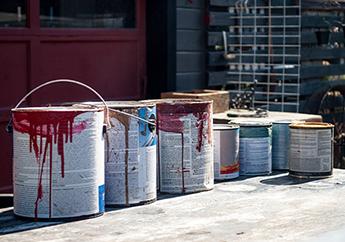
Traditional paints contain volatile organic compounds (VOCs), which are a variety of chemicals that can easily become a vapor or gas and evaporate into the air. If breathed in by nearby individuals, the vapors can cause headaches, dizziness and breathing problems. If paint is improperly disposed, it can contaminate our drinking water and groundwater, killing fish and other organisms in our lakes and streams. It only takes a small amount of paint to contaminate thousands of gallons of water.
Reduce, Reuse, Recycle
Each year, an average of two gallons of paint is sold per person in the United States and more than 60 million gallons of paint are left over. You can reduce the amount of paint you need to dispose by only buying what you need for the job at hand. Homeadvisor.com provides an online paint calculator to help you determine how much paint you need. By properly storing and organizing the paint you buy, you can maintain product integrity and avoid buying what you already have. You can also increase safety by reading labels carefully and trying to avoid buying products labeled danger, warning, caution, flammable, explosive, corrosive, caustic, toxic or poison.
Before you dispose your unwanted paint, consider sharing it with a friend or neighbor or donating it to a charity organization, school, church or theater group. Habitat for Humanity will take gallons of paint that are almost full. The Salvation Army only accepts cans of paint that have not been opened.
Disposal
If you do have paint that needs to be disposed, do not pour it down storm water or household drains. How the paint needs to be disposed, depends on the type of paint.
Water based paint is non-hazardous when solidified. The preferred disposal option is to find a collection center or retailer that accepts unwanted paint. If this option is not possible, open the paint can and add shredded newspaper, sand, kitty litter or waste paint hardener (available at home improvement stores). Thoroughly mix the paint and leave the paint can open to dry, somewhere away from children and pets. When the paint has solidified, close the paint can and dispose with your household trash.
Oil-based paint needs to be disposed at a collection center or paint retailer. The department maintains a list of permanent household hazardous waste collection facilities in Missouri. Paintcare.org and Earth911 provide online databases you can search for paint drop-off locations in your area. You can also participate in a collection event hosted by your city, county or solid waste management district. You can also search the Missouri Materials Management Directory to find local contractors, vendors and drop-off locations offering recycling, reuse and disposal services.
Thermometers
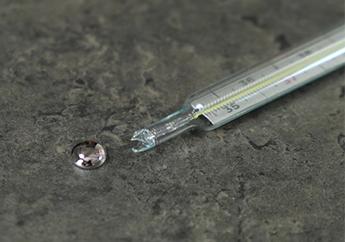
Some thermostats and thermometers contain mercury, the silver colored liquid inside a glass ball, which changes with temperature and pressure. Mercury thermostats contain about 3-12 grams of mercury. If the glass bulb containing the mercury breaks, the exposed mercury can evaporate and individuals can easily breathe in toxic levels of mercury vapor.* If an intact thermostat or thermometer is improperly disposed, it could break and the mercury could contaminate our soil, groundwater, lakes and streams.
*For information about how to clean up a broken mercury thermometer or thermostat, review Cleaning up a Mercury Spill - PUB2980.
Reduce, Reuse, Recycle
If you need to replace a thermometer or thermostat, replace it with a mercury-free (or lower-mercury) option. Electronic and magnetic snap switch thermostats do not contain mercury. Digital thermometers and some liquid-in-glass thermometers do not contain mercury. Look for thermometers labeled as “mercury-free.”
Disposal
In order to minimize exposure and prevent mercury pollution, do not throw thermostats and thermometers in your household trash. Contact your local solid waste management district for disposal options. For more information about how to dispose your thermostats, visit Thermostat Recycling Corporations.
Popular Links
Contact Information
Waste Management Program
Division of Environmental Quality
P.O. Box 176
Jefferson City, MO 65102-0176
United States
